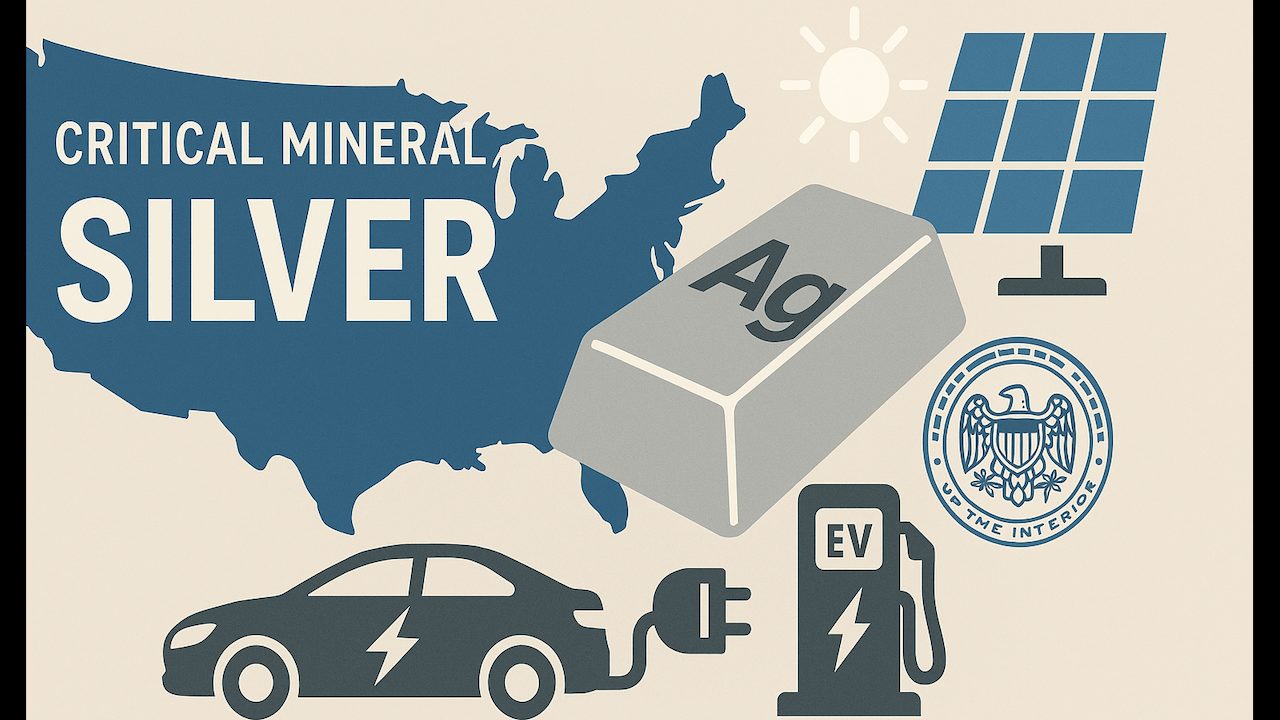(Mike Maharrey, Money Metals News Service) U.S. Geological Survey (USGS) has officially added silver to its list of “critical minerals.” This could put further demand pressure on a metal already in short supply. It also increases the possibility of tariffs on silver.
The USGS critical mineral list was established in 2017, and it guides federal strategy, investment, and mine permitting decisions.
USGS defines a critical mineral as, “Those commodities which are essential to the economic or national security of the U.S.; have a supply chain that is vulnerable to disruption; and serve an essential function in the manufacturing of a product, the absence of which would have significant consequences for the economic or national security of the U.S.”
The USGS also added copper, metallurgical coal, potash, rhenium, silicon, and lead to the list.
According to a Department of the Interior press release, “The List of Critical Minerals informs direct investments in mining and resource recovery from mine waste; stockpiles; tax incentives for U.S. mineral processing; and streamlined mining permitting.”
The Bipartisan Policy Center said inclusion on the list can make projects eligible for federal funding, subject to a streamlined permitting process, or more competitive due to fees placed on imports.
The director of the minerals security program at the Center for Strategic and International Studies told the Financial Times, “This list is a signal to the market about what the US government is prioritizing. It will be easier to line up government support for a mineral designated as ‘critical.’”
Interior Secretary Doug Burgum said, “This draft list of critical minerals provides a clear, science-based roadmap to reduce our dependence on foreign adversaries, expand domestic production, and unleash American innovation.”
Silver Supply Tightness
The declaration of silver as a critical mineral could increase demand in a market already burdened by tight supply.
About 60 percent of global silver offtake is for industrial purposes. Industrial demand for silver set a record last year, and it continues to grow.
Metals Focus Director of Gold and Silver Matthew Piggott told Kitco News, “There’s definitely going to be far more tightness in the silver market,” with the new designation.
The silver supply is already becoming increasingly tight. Demand outstripped the silver supply for the fourth consecutive year in 2024. The structural market deficit came in at 148.9 million ounces. That drove the four-year market shortfall to 678 million ounces, the equivalent of 10 months of mining supply in 2024.
Analysts forecast another supply deficit in 2025.
Sagging supply is likely one of the factors driving the decision to include silver on the list of critical minerals.
U.S. silver mine output was up by about 6 percent in 2024. The U.S. produced about 1,100 tonnes of metal. However, output has generally been flat over the last five years.
Globally, mine output has sagged since peaking in 2016.
Metals Focus forecasts that while we will see record silver prices over the next five years, “mine supply growth is likely to remain modest, with only minimal increases globally.”
Why won’t silver production ramp up to meet the demand and take advantage of these higher prices?
Metals Focus blames the price inelasticity on the fact that more than half of silver is mined as a byproduct of base metal operations.
“Although silver can be a significant revenue stream, the economics and production plans of these mines are primarily driven by the markets for copper, lead and zinc. Consequently, even significant increases in silver prices are unlikely to influence production plans that are dependent on other metals.”
About 28 percent of the silver supply is derived from primary silver mines, where production is more tightly tied to price. But silver mines face their own challenges, including declining ore grades and rapidly rising mining costs.
Domestic silver miners could get a boost from the classification of silver as a critical mineral, but it won’t necessarily alleviate the fundamental issue in the silver market — rapidly increasing demand and structurally tight supply.
Tariff Worries
There are concerns that designating silver as a critical mineral could lead to import tariffs to protect and incentivize domestic silver production. Analysts say this threat could further complicate the silver market and the already fragile global supply chain.
Tariff worries led to a surge of metal into the U.S. last April, depleting London vaults. This set the stage for a silver squeeze in October. Demand surged as the price pushed toward $50. This coincided with the festival season in India, creating even more demand pressure. The squeeze was eventually alleviated by moving metal from New York; however, this didn’t resolve the underlying problem – there simply isn’t enough metal.
So far, silver and gold have been exempted from tariffs. However, some analysts think the critical mineral designation could put U.S. tariffs on silver back on the table. If domestic silver production becomes a priority, it could lead to trade restrictions.
Piggott said the only long-term solution to the supply problem is more silver to meet the demand.
“It’ll only be rectified if we end up with surpluses in the silver market going forward. Certainly, for this year, we’re going to end up with another deficit. Looking into next year, we’ll see the same because we won’t have significant industrial weakness to reduce silver consumption.”
Mike Maharrey is a journalist and market analyst for Money Metals with over a decade of experience in precious metals. He holds a BS in accounting from the University of Kentucky and a BA in journalism from the University of South Florida.

